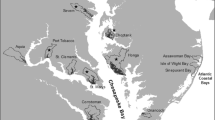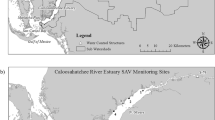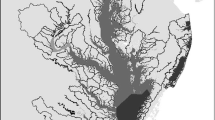Abstract
Watershed land use can affect submerged aquatic vegetation (SAV) by elevating nutrient and sediment loading to estuaries. We analyzed the effects of watershed use and estuarine characteristics on the spatial variation of SAV abundance among 101 shallow subestuaries of Chesapeake Bay during 1984–2003. Areas of these subestuaries range from 0.1 to 101 km2, and their associated local watershed areas range from 6 to 1664 km2. Watershed land cover ranges from 6% to 81% forest, 1% to 64% cropland, 2% to 38% grassland, and 0.3% to 89% developed land. Landscape analyses were applied to develop a number of subestuary metrics (such as subestuary area, mouth width, elongation ratio, fractal dimension of shoreline, and the ratio of local watershed area to subestuary area) and watershed metrics (such as watershed area). Using mapped data from aerial SAV surveys, we calculated SAV coverage for each subestuary in each year during 1984–2003 as a proportion of potential SAV habitat (the area < 2 m deep). The variation in SAV abundance among subestuaries was strongly linked with subestuary and watershed characteristics. A regression tree model indicated that 60% of the variance in SAV abundance could be explained by subestuary fractal dimension, mean tidal range, local watershed dominant land cover, watershed to subestuary area ratio, and mean wave height. Similar explanatory powers were found in wet and dry years, but different independent variables were used. Repeated measures ANOVA with multiple-mean comparison showed that SAV abundance declined with the dominant watershed land cover in the order: forested, mixed-undisturbed, or mixed-developed > mixed-agricultural > agricultural > developed. Change-point analyses indicated strong threshold responses of SAV abundance to point source total nitrogen and phosphorus inputs, the ratio of local watershed area to subestuary area, and septic system density in the local watershed.
Similar content being viewed by others
Literature Cited
Ahronditsis, G. B., H. W. Paerl, L. M. Valdes-Weaver, C. A. Stow, L. J. Steinberg, andK. H. Reckhow. 2007. Application of Bayesian structural equation modeling for examining phyto-plankton dynamics in the Neuse River Estuary (North Carolina, USA).Estuarine Coastal and Shelf Science 72:63–80.
Allord, G. J. 1992. 1 to 2,000,000 hydrologic unit map of the conterminous United States (digital data set). U.S. Geological Survey, Reston, Virginia.
Baker, M. E., D. E. Weller, andT. E.Jordan. 2006. Comparison of automated watershed delineations: Effects on land cover areas, percentages, and relationships to nutrient discharge.Photogrammetric Engineering and Remote Sensing 72:159–168.
Batiuk, R. A. andP. W. Bergstrom. 2000. Introduction, p. 1–2.In Chesapeake Bay Submerged Aquatic Vegetation Water Quality and Habitat-based Requirements and Restoration Targets: A second technical synthesis, CBP/TRS 245/00, EPA 903-R-00-014. Chesapeake Bay Program, Annapolis, Maryland.
Beaulac, M. N. andK. H. Reckhow. 1982. An examination of land use -nutrient export relationships.Water Resources Bulletin 18: 1013–1022.
Bilkovic, D. M., M. Roggero, C. H. Hershner, andK. H. Havens. 2006. Influence of land use on macrobenthic communities in nearshore estuarine habitats.Estuaries and Coasts 29:1185–1195.
Breitburg, D. 2002. Effects of hypoxia, and the balance between hypoxia and enrichment, on coastal fishes and fisheries.Estuaries 25:767–781.
Brooks, R. P., D. H. Wardrop, K. W. Thornton, D. Whigham, C. Hershner, M. M. Brinson, and J. S. Shortle (EDS.). 2006, Integration of ecological and socioeconomic indicators for estuaries and watersheds of the Atlantic Slope. Final Report to U.S. Environmental Protection Agency STAR Program, Agreement R-82868401. Atlantic Slope Consortium, University Park, Pennsylvania.
Caruso, V. 1987. Standards for digital elevation models, p. 159–166.In ASPRS-ACSM Annual Convention. American Society for Photogrammetry and Remote Sensing and American Congress on Surveying and Mapping, Volume 4. Falls Church, Virginia.
Cerco, C. F. 1995. Response of Chesapeake Bay to nutrient load reductions.Journal of Environmental Engineering -ASCE 121:549–557.
Cerco, C. F. andT. Cole. 1993. Three dimensional eutrophication model of Chesapeake Bay.Journal of Environmental Engineering -ASCE 119:1006–1025.
Cerco, C. F., L. Linker, J. Sweeney, G. Shenk, andA. J. Butt. 2002. Nutrient and solids controls in Virginia’s Chesapeake Bay tributaries.Journal of Water Resources Planning and Management -ASCE 128:179–189.
Cerco, C. F. andK. A. Moore. 2001. System-wide submerged aquatic vegetation model for Chesapeake Bay.Estuaries 24:522–534.
Clarke, S. M. 1987. Seagrass-sediment dynamics in Holdfast Bay: Summary.Safish 11:4–10.
Cohen, L. M. 1994. Bathymetric data held at the National Geophysical-Data Center.Marine Georesources and Geotechnology 12:53–60.
Comeleo, R. L., J. F. Paul, P. V. August, J. Copeland, C. Baker, S. S. Hale, andR. L. Latimer. 1996. Relationships between watershed Stressors and sediment contamination in Chesapeake Bay estuaries.Landscape Ecology 11:307–319.
Dauer, D. M., J. A. Ranasinghe, andS. B. Weisberg. 2000. Relationships between benthic community condition, water quality, sediment quality, nutrient loads, and land use patterns in Chesapeake Bay.Estuaries 23:80–96.
De’Ath, G. andK. E. Fabricius. 2000. Classification and regression trees: A powerful yet simple technique for ecological data analysis.Ecology 81:3178–3192.
Deegan, L. A., J. T. Finn, S. G. Awazian, C. A. Ryder-Kieffer, andJ. Buonaccorsi. 1997. Development and validation of an estuarine biotic integrity index.Estuaries 20:601–617.
Deluca, W. V., C. E. Studds, L. L. Rockwood, andP. P. Marra. 2004. Influence of land use on the integrity of marsh bird communities of Chesapeake Bay, USA.Wetlands 24:837–847.
Dennison, W. C., R. J. Orth, K. A. Moore, J. C. Stevenson, V. Carter, S. Kollar, P. W. Bergstrom, andR. A. Batiuk. 1993. Assessing water-quality with submersed aquatic vegetation.Bioscience 43:86–94.
Desmond, J. S., D. H. Deutschman, andJ. B. Zedler. 2002. Spatial and temporal variation in estuarine fish and invertebrate assemblages: Analysis of an 11-year data set.Estuaries 25:552–569.
Federal Geographic Data Committee (FGDC). 2001. Shoreline Metadata Profile of the Content Standards for Digital Geospatial Metadata. Reston, Virginia.
Ferguson, R. L., L. L. Wood, andD. B. Graham. 1993. Monitoring spatial change in seagrass habitat with aerial photography.Photogrammetric Engineering and Remote Sensing 59:1033–1038.
Ferrarini, A., P. Rossi, andO. Rossi. 2005. Ascribing ecological meaning to habitat shape by means of a piecewise regression approach to fractal domains.Landscape Ecology 20:799–809.
Frink, C. R. 1991. Estimating nutrient exports to estuaries.Journal of Environmental Quality 20:717–724.
Gallegos, G L. 2001. Calculating optical water quality targets to restore and protect submersed aquatic vegetation: Overcoming problems in partitioning the diffuse attenuation coefficient for photosynthetically active radiation.Estuaries 24:381–397.
Gallegos, C. L. andP. W. Bergstorm. 2005. Effects of aProrocentrum minimum bloom on light availability for and potential impacts on submerged aquatic vegetation in upper Chesapeake Bay.Harmful Algae 4:553–574.
Gallegos, C. L., T. E. Jordan, andD. L. Correll. 1992. Eventscale response of phytoplankton to watershed inputs in a subestuary-timing, magnitude, and location of blooms.Limnology and Oceanography 37:813–828.
Gallegos, C. L., T. E. Jordan, andD. L. Correll. 1997. Interannual variability in spring bloom timing and magnitude in the Rhode River, Maryland, USA: Observations and modeling.Marine Ecology Progress Series 154:27–40.
Gornitz, V. andT. W. White. 1992. A coastal hazards database for the U.S. East Coast. ORNL/CDIAC-45, NDP-043A. Oak Ridge National Laboratory, Oak Ridge, Tennessee.
Hale, S. S., J. F. Paul, andJ. F. Heltshe. 2004. Watershed landscape indicators of estuarine benthic condition.Estuaries 27:283–295.
Homer, C., C. Huang, L. Yang, B. Wylie, andM. Coan. 2004. Development of a 2001 National Land-Cover Database for the United States.Photogrammetric Engineering and Remote Sensing 70: 829–840.
Hubertz, J. M., E. F. Thompson, andH. V. Wang. 1996. Wave information studies of U.S. coastlines: Annotated bibliography on coastal and ocean data assimilation. WIS Report 36, U.S. Army Engineer Waterways Experiment Station, Vicksburg, Mississippi.
Jordan, T. E., D. E. Correll, andD. E. Weller. 1997a. Nonpoint source discharges of nutrients from Piedmont watersheds of Chesapeake Bay.Journal of American Water Resources Association 33:631–645.
Jordan, T. E., D. E. Correll, andD. E. Weller. 1997b. Effects of agriculture on discharges of nutrients from coastal plain watersheds of Chesapeake Bay.Journal of Environmental Quality 26:836–848.
Jordan, T. E., D. E. Correll, andD. E. Weller. 2000. Mattawoman creek watershed nutrient and sediment dynamics: Final contract report to Charles County, Maryland. Smithsonian Environmental Research Center, Edgewater, Maryland.
Jordan, T. E., D. E. Weller, andD. L. Correll. 2003. Sources of nutrient inputs to the Patuxent River estuary.Estuaries 26:226–243.
Kemp, W. M., R A. Batiuk, R. Bartleson, P. W. Bergstrom, V. Carter, C. L. Gallegos, W. Hunley, L. Karrh, E. W. Koch, J. M. Landwehr, K. A. Moore, L. Murray, M. Naylor, N. B. Rybicki, J. C. Stevenson, andD. J. Wilcox. 2004. Habitat requirements for submerged aquatic vegetation in Chesapeake Bay: Water quality, light regime, and physical-chemical factors.Estuaries 27: 363–377.
Kendrick, G. A., J. Eckersley, andD. I. Walker. 1999. Landscape-scale changes in seagrass distribution over time: A case study from Success Bank, Western Australia.Aquatic Botany 65:293–309.
King, R. S., J. Beaman, D. F. Whigham, A. H. Hines, M. E. Baker, andD. E. Weller. 2004. Watershed land use is strongly linked to PCBs in white perch in Chesapeake Bay subestuaries.Environmental Science and Technology 38:6546–6552.
King, R. S., A. H. Hines, F. D. Craige, andS. Grap. 2005. Regional, watershed, and local correlates of blue crab and bivalve abundances in subestuaries of Chesapeake Bay, USA.Journal of Experimental Marine Biology and Ecology 319:101–116.
Koch, E. W. 2001. Beyond light: Physical, geological, and geochemical parameters as possible submersed aquatic vegetation habitat requirements.Estuaries 24:1–17.
Koch, E. W. andG. Gust. 1999. Water flow in tide and wave dominated beds of the seagrassThalassia testudinum.Marine Ecology Progress Series 184:63–72.
Lehmann, A., J. M. Jaquet, andJ. B. Lachavanne. 1997. A GIS approach of aquatic plant spatial heterogeneity in relation to sediment and depth gradients, Lake Geneva, Switzerland.Aquatic Botany 58:347–361.
Lerberg, S. B., A. F. Holland, andD. M. Sanger. 2000. Responses of tidal creek macrobenthic communities to the effects of watershed development.Estuaries 23:838–853.
Lubbers, L., W. R. Boynton, andW. M. Kemp. 1990. Variations in structure of estuarine fish communities in relation to abundance of submersed vascular plants.Marine Ecology Progress Series 65:1–14.
Moore, K. A., D. L. Wilcox, andR. J. Orth. 2000. Analysis of abundance of submersed aquatic vegetation communities in the Chesapeake Bay.Estuaries 23:115–127.
Nizeyimana, E., G. W. Petersen, M. C. Anderson, B. M. Evans, J. M. Hamlett, andG. M. Baumer. 1996. Statewide GIS/Census data assessment of nitrogen loadings from septic systems in Pennsylvania.Journal of Environmental Quality 25:346–354.
O’Rourke, N., L. Hatcher, andE. J. Stepanski. 2005. A Step-by-Step Approach to Using SAS for Univariate and Multivariate Statistics, 2nd edition. SAS Institute, Inc., Cary, North Carolina.
Orth, R. J., R. A. Batiuk, andP. Heasly. 1992. Chesapeake Bay restoration targets, p. 10–136.In Submerged Aquatic Vegetation Habitat Requirements and Restoration Targets: A technical synthesis CBP/TRS 83/92. U.S. Environmental Protection Agency Chesapeake Bay Program, Annapolis, Maryland.
Orth, R. J. andK. A. Moore. 1983. Chesapeake Bay: An unprecedented decline in submerged aquatic vegetation.Science 222:51–53.
Orth, R. J., D. J. Wilcox, L. S. Nagey, A. L. Owens, J. R Whiting, andA. Serio. 2004. 2003 Distribution of Submerged Aquatic Vegetation in the Chesapeake Bay and Coastal Bays. VIMS Special Scientific Report Number 144. Virginia Institute of Marine Sciences, Gloucester Point, Virginia.
Paul, J. F., R. L. Comeleo, andJ. Copeland. 2002. Landscape metrics and estuarine sediment contamination in the Mid-Atlantic and southern New England regions.Journal of Environmental Quality 31:836–845.
Pugesek, B. H., A. Tomer, andA. Von Eye. 2003. Structural Equation Modeling: Applications in Ecological and Evolutionary Biology. Cambridge University Press, Cambridge, U.K.
Qian, S. S., R. S. King, andC. J. Richardson. 2003. Two statistical methods for the detection of environmental thresholds.Ecological Modelling 166:87–97.
Rietkerk, M., S. C. Dekker, M. J. Wassen, A. W. M. Verkroost, andM. F. P. Bierkens. 2004. A putative mechanism for bog patterning.American Naturalist 163:699–708.
Robbins, B. D. 1997. Quantifying temporal change in seagrass areal coverage: The use of GIS and low resolution aerial photography.Aquatic Botany 58:259–267.
Rodriguez, W., P. V. August, Y. Wang, J. F. Paul, A. Gold, andN. Rubinstein. 2007. Empirical relationships between land use/ cover and estuarine condition in the northeastern United States.Landscape Ecology 22:403–417.
SAS Institute, Inc. 1999. SAS/STAT User’s Guide, Version 8. SAS Institute, Inc., Cary, North Carolina.
Scheffer, M. andS. R. Carpenter. 2003. Catastrophic regime shifts in ecosystems: Linking theory to observation.Trends in Ecology and Evolution 18:648–656.
Scheffer, M., S. R. Carpenter, J. A. Foley, C. Folke, andB. H. Walker. 2001. Catastrophic shifts in ecosystems.Nature 413: 591–696.
Schubel, J. R. andD. W. Pritchard. 1986. Responses of upper Chesapeake Bay to variations in discharge of the Susquehanna River.Estuaries 9:236–249.
Schueler, T. R. 1987. Controlling urban runoff: A practical manual for planning and designing urban BMPs. Department of Environmental Programs, Metropolitan Washington Council of Governments, Washington, D.C.
Short, F. T. andD. M. Burdick. 1996. Quantifying eelgrass habitat loss in relation to housing development and nitrogen loading in Waquoit Bay, Massachusetts.Estuaries 19:730–739.
Staver, L. W., K. W. Staver, andJ. C. Stevenson. 1996. Nutrient inputs to the Choptank River estuary: Implications for watershed management.Estuaries 19:342–358.
Stevenson, J. C., L. W. Staver, andK. W. Staver. 1993. Water quality associated with survival of submerged aquatic vegetation along an estuarine gradient.Estuaries 16:346–361.
Therneau, T. M. andE. J. Atkinson. 1997. An introduction to recursive partitioning using the RPART routines. Technical Report 61, Department of Health Science Research, Mayo Clinic, Rochester, Minnesota.
Thieler, E. R. andE. S. Hammar-Klose. 1999. National assessment of coastal vulnerability to future sea-level rise: Preliminary results for the U.S. Atlantic coast Open-File Report 99-593. U.S. Geological Survey, Washington, D.C.
Urban, D. L. 1987. Landscape ecology: A hierarchical perspective can help scientists understand spatial patterns.Bioscience 37: 119–127.
U.S. Environmental Protection Agency (USEPA). 2003. Technical support document for identification of Chesapeake Bay designated uses and attainability EPA 903-R-03-004. U.S. EPA Chesapeake Bay Program, Annapolis, Maryland.
U.S. Environmental Protection Agency (USEPA). 2004. Chesapeake Bay Program: Analytical segmentation scheme -Revisions, decisions and rationales: 1983–2003. U.S. Environmental Protection Agency Chesapeake Bay Program, Annapolis, Marylds.
U.S. Geological Survey. 1999. Standards for National Hydrography Dataset: U.S. Geological Survey. Reston, Virginia.
Venables, W. N. andR. D. Ripley. 2002. Modern Applied Statistics with S-Plus. 2nd edition Springer-Verlag, New York.
Weller, D. E., T. E.Jordan, D. L. Correll, andZ. J. Liu. 2003. Effects of land-use change on nutrient discharges from the Patuxent River watershed.Estuaries 26:244–266.
Weiskel, P. K. andB. L. Howes. 1992. Differential transport of sewage-based nitrogen and phosphorus through a coastal watershed.Environmental Science and Technology 26:352–359.
Wiedeman, A. andA. Cosgrove. 1998. Chesapeake Bay Watershed model application and calculation of nutrient and sediment loadings. Appendix F: Point Source Loadings. A report of the Chesapeake Bay Program Nutrient Subcommittee. U.S. EPA Chesapeake Bay Program, Annapolis, Maryland.
Zharikov, Y., G. A. Skilleter, N. R. Loneragan, T. Taranto, andB. E. Cameron. 2005. Mapping and characterizing subtropical estuarine landscapes using aerial photography and GIS for potential application in wildlife conservation and management.Biological Conservation 125:87–100.
Source of Unpublished Data
Orth, R. personal communication. Virginia Institute of Marine Sciences, P.O. Box 1346, Gloucester Point, Virginia 23062–1346.
Author information
Authors and Affiliations
Corresponding author
Rights and permissions
About this article
Cite this article
Li, X., Weller, D.E., Gallegos, C.L. et al. Effects of watershed and estuarine characteristics on the abundance of submerged aquatic vegetation in Chesapeake Bay subestuaries. Estuaries and Coasts: J ERF 30, 840–854 (2007). https://doi.org/10.1007/BF02841338
Received:
Revised:
Accepted:
Issue Date:
DOI: https://doi.org/10.1007/BF02841338




